Scientific name Gulo gulo Trophic level Carnivorous | Suborder Caniformia Genus GuloPallas, 1780 Mass 9 – 25 kg (Adult) Higher classification Gulo | |
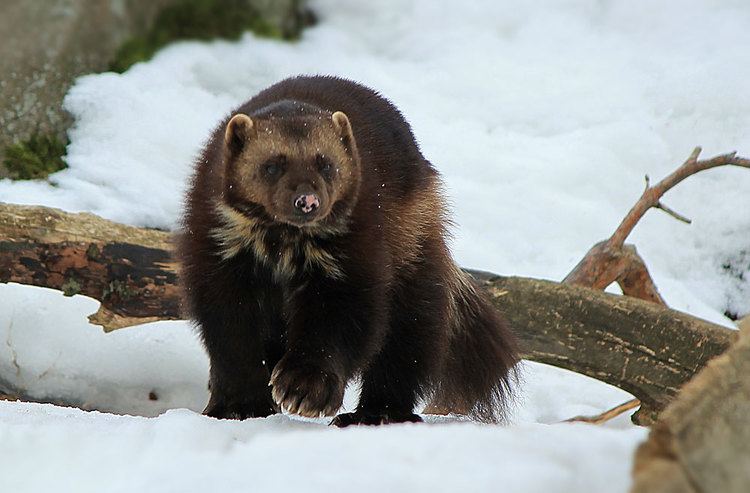 | ||
Conservation status Least Concern (Population decreasing) Lifespan 5 – 13 years (In the wild) Similar Gray wolf, Mustelids, Eurasian lynx, European badger, Honey badger | ||
Wolverines are the honey badgers of the north
The wolverine (/ˈwʊlvəriːn/), Gulo gulo (Gulo is Latin for "glutton"), also referred to as the glutton, carcajou, skunk bear, or quickhatch, is the largest land-dwelling species of the family Mustelidae (weasels). It is a stocky and muscular carnivore, more closely resembling a small bear than other mustelids. The wolverine, a solitary animal, has a reputation for ferocity and strength out of proportion to its size, with the documented ability to kill prey many times larger than itself.
Contents
- Wolverines are the honey badgers of the north
- Wolverine face off
- Taxonomy
- Physical characteristics
- Diet and hunting
- Natural enemies
- Mating and reproduction
- Distribution
- Conservation
- In captivity
- Name
- In culture
- References
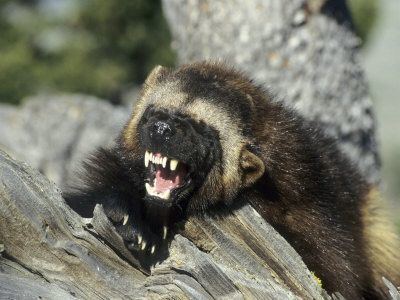
The wolverine is found primarily in remote reaches of the Northern boreal forests and subarctic and alpine tundra of the Northern Hemisphere, with the greatest numbers in northern Canada, the US state of Alaska, the mainland Nordic countries of Europe, and throughout western Russia and Siberia. Its population has steadily declined since the 19th century owing to trapping, range reduction and habitat fragmentation. The wolverine is now essentially absent from the southern end of its European range.
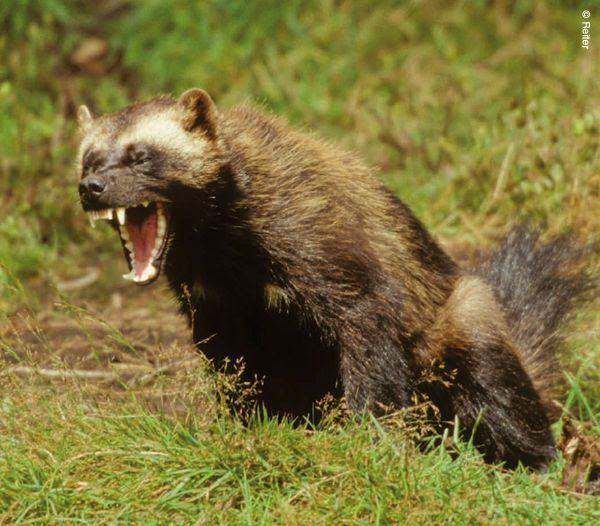
Wolverine face off
Taxonomy
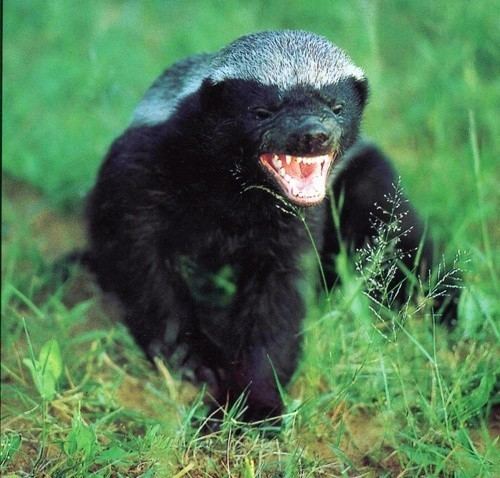
Genetic evidence suggests that the wolverine is most closely related to the tayra and martens, all of which shared a Eurasian ancestor.

Within the Gulo genus, a clear separation occurs between two subspecies: the Old World form Gulo gulo gulo and the New World form G. g. luscus. Some authors had described as many as four additional North American subspecies, including ones limited to Vancouver Island (G. g. vancouverensis) and the Kenai Peninsula in Alaska (G. g. katschemakensis). However, the most currently accepted taxonomy recognizes either the two continental subspecies or recognize G. gulo as a single Holarctic taxon.
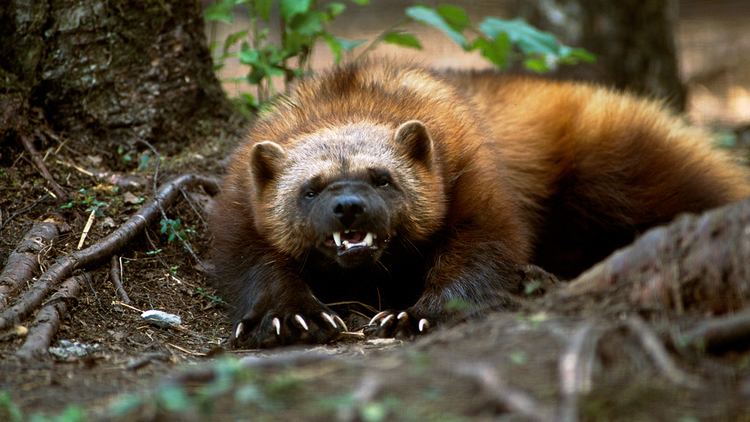
Recently compiled genetic evidence suggests most of North America's wolverines are descended from a single source, likely originating from Beringia during the last glaciation and rapidly expanding thereafter, though considerable uncertainty to this conclusion is due to the difficulty of collecting samples in the extremely depleted southern extent of the range.
Physical characteristics

Anatomically, the wolverine is a stocky and muscular animal. With short legs, broad and rounded head, small eyes and short rounded ears, it more closely resembles a bear than it does other mustelids. Though its legs are short, its large, five-toed paws with crampon-like claws and plantigrade posture enable them to climb up and over steep cliffs, trees and snow-covered peaks with relative ease.
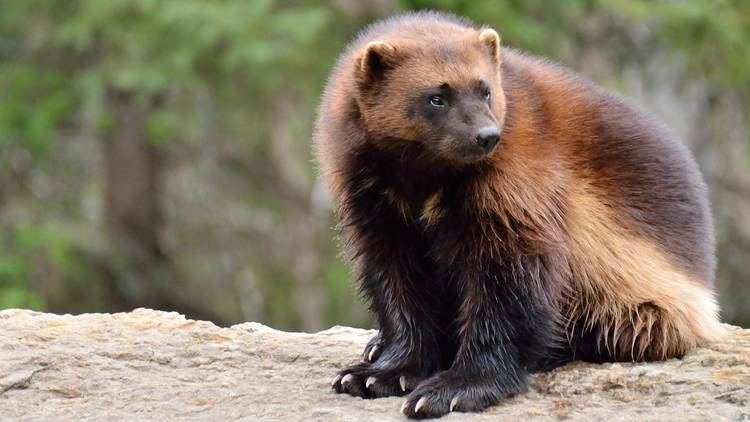
The adult wolverine is about the size of a medium dog, with a length usually ranging from 65–107 cm (26–42 in), a tail of 17–26 cm (6.7–10.2 in), and a weight of 9–25 kg (20–55 lb), though exceptionally large males can weigh up to 32 kg (71 lb). The males are as much as 30% larger than the females and can be twice the females' weight. Shoulder height is reported from 30 to 45 cm (12 to 18 in). It is the largest of terrestrial mustelids; only the marine-dwelling sea otter, the giant otter of the Amazon basin and the semi-aquatic African clawless otter are larger, while the hog badger may reach a similar size.
Wolverines have thick, dark, oily fur which is highly hydrophobic, making it resistant to frost. This has led to its traditional popularity among hunters and trappers as a lining in jackets and parkas in Arctic conditions. A light-silvery facial mask is distinct in some individuals, and a pale buff stripe runs laterally from the shoulders along the side and crossing the rump just above a 25–35 cm (9.8–13.8 in) bushy tail. Some individuals display prominent white hair patches on their throats or chests.
Like many other mustelids, it has potent anal scent glands used for marking territory and sexual signaling. The pungent odor has given rise to the nicknames "skunk bear" and "nasty cat." Wolverines, like other mustelids, possess a special upper molar in the back of the mouth that is rotated 90 degrees, towards the inside of the mouth. This special characteristic allows wolverines to tear off meat from prey or carrion that has been frozen solid.
Diet and hunting
Wolverines are considered to be primarily scavengers. A majority of the wolverine's sustenance is derived from carrion, on which they depend almost exclusively in winter and early spring. Wolverines may find carrion themselves, feed on it after the predator is done feeding (especially wolf packs) or simply take it from another predator. Wolverines are also known to follow wolf and lynx trails, purportedly with the intent of scavenging the remains of their kills. Whether eating live prey or carrion, the wolverine's feeding style appears voracious, leading to the nickname of "glutton" (also the basis of the scientific name). However, this feeding style is believed to be an adaptation to food scarcity, especially in winter.
The wolverine is also a powerful and versatile predator. Prey mainly consists of small to medium-sized mammals, but the wolverine has been recorded killing prey such as adult deer that are many times larger than itself. Prey species include porcupines, squirrels, chipmunks, beavers, marmots, moles, gophers, rabbits, voles, mice, rats, shrews, lemmings, caribou, roe deer, white-tailed deer, mule deer, sheep, goats, cattle, bison, moose, and elk. Smaller predators are occasionally preyed on, including martens, mink, foxes, Eurasian lynx, weasels, and coyote and wolf pups. Wolverines have also been known to kill Canadian lynx in the Yukon of Canada. Wolverines often pursue live prey that are relatively easy to obtain, including animals caught in traps, newborn mammals, and deer (including adult moose and elk) when they are weakened by winter or immobilized by heavy snow. Their diets are sometimes supplemented by birds' eggs, birds (especially geese), roots, seeds, insect larvae, and berries.
Wolverines inhabiting the Old World (specifically, Fennoscandia) hunt more actively than their North American relatives. This may be because competing predator populations in Eurasia are not as dense, making it more practical for the wolverine to hunt for itself than to wait for another animal to make a kill and then try to snatch it. They often feed on carrion left by wolves, so changes in wolf populations may affect the population of wolverines. They are also known on occasion to eat plant material.
Wolverines frequently cache their food during times of plenty. This is of particular importance to lactating females in the winter and early spring, a time when food is scarce.
Natural enemies
Wolves are thought to be the wolverine's most important natural predator, with the arrival of wolves to a wolverine's territory presumably leading the latter to abandon the area. Armed with powerful jaws, sharp claws, and a thick hide, wolverines, like most mustelids, are remarkably strong for their size. They may defend kills against larger or more numerous predators such as wolves or bears. At least one account reported a wolverine's apparent attempt to steal a kill from a black bear, although the bear won what was ultimately a fatal contest. In another account, a wolverine killed a polar bear.
Mating and reproduction
Successful males will form lifetime relationships with two or three females, which they will visit occasionally, while other males are left without a mate. Mating season is in the summer, but the actual implantation of the embryo (blastocyst) in the uterus is stayed until early winter, delaying the development of the fetus. Females will often not produce young if food is scarce. The gestation period is 30–50 days, and litters of typically two or three young ("kits") are born in the spring. Kits develop rapidly, reaching adult size within the first year of a lifespan that may reach anywhere from five to (in exceptional individuals) 13 years. Fathers make visits to their offspring until they are weaned at 10 weeks of age; also, once the young are about six months old, some reconnect with their fathers and travel together for a time.
Distribution
Wolverines live primarily in isolated arctic and alpine regions of northern Canada, Alaska, Siberia, and Scandinavia; they are also native to European Russia, the Baltic countries, the Russian Far East, northeast China and Mongolia. In 2008 and 2009, wolverines were sighted as far south as the Sierra Nevada, near Lake Tahoe, for the first time since 1922. They are also found in low numbers in the Rocky Mountains and northern Cascades of the United States, and have been sighted as far south and east as Michigan. However, most New World wolverines live in Canada.
Conservation
The world's total wolverine population is not known. The animal exhibits a low population density and requires a very large home range. The wolverine is listed by the IUCN as Least Concern because of its "wide distribution, remaining large populations, and the unlikelihood that it is in decline at a rate fast enough to trigger even Near Threatened".
The range of a male wolverine can be more than 620 km2 (240 mi2), encompassing the ranges of several females which have smaller home ranges of roughly 130–260 km2 (50–100 mi2). Adult wolverines try for the most part to keep nonoverlapping ranges with adults of the same sex. Radio tracking suggests an animal can range hundreds of miles in a few months.
Female wolverines burrow into snow in February to create a den, which is used until weaning in mid-May. Areas inhabited nonseasonally by wolverines are thus restricted to zones with late-spring snowmelts. This fact has led to concern that global warming will shrink the ranges of wolverine populations.
This requirement for large territories brings wolverines into conflict with human development, and hunting and trapping further reduce their numbers, causing them to disappear from large parts of their former range; attempts to have them declared an endangered species have met with little success. In February 2013, the United States Fish and Wildlife Service proposed giving Endangered Species Act protections to the wolverine due to its winter habitat in the northern Rockies diminishing. This was as a result of a lawsuit brought by the Center for Biological Diversity and Defenders of Wildlife.
The Wildlife Conservation Society reported in June 2009 that a wolverine researchers had been tracking for almost three months had crossed into northern Colorado. Society officials had tagged the young male wolverine in Wyoming near Grand Teton National Park and it had traveled southward for about 500 miles. It was the first wolverine seen in Colorado since 1919, and its appearance was also confirmed by the Colorado Division of Wildlife. In February 2014, a wolverine was seen in Utah, the first confirmed sighting in that state in 30 years. In May 2016 a cattle ranch-hand in North Dakota came upon a wolverine in the midst of his herd and shot it dead. This was the first verified sighting of a Wolverine in North Dakota in 150 years.
In captivity
Around a hundred wolverines are held in zoos across North America and Europe, and they have been bred in captivity, but only with difficulty and high infant mortality.
Name
The wolverine's questionable reputation as an insatiable glutton (reflected in the Latin genus name Gulo) may be in part due to a false etymology. The animal's name in older Norwegian, fjeldfross, meaning "mountain cat", is thought to have worked its way into German as Vielfraß, which means "glutton" (literally "devours much"). Its name in other West Germanic languages is similar (e.g. Dutch: veelvraat).
The Finnish name is ahma, derived from ahmatti, which is translated as "glutton". Similarly, the Estonian name is ahm, with the equivalent meaning to the Finnish name. In Lithuanian is ernis, in Latvian—tinis or āmrija.
The Eastern Slavic росомаха (rosomakha) and the Polish and Czech name rosomák seem to be borrowed from the Finnish rasva-maha (fat belly). Similarly, the Hungarian name is rozsomák or torkosborz which means "gluttonous badger".
In French-speaking parts of Canada, the wolverine is referred to as carcajou, borrowed from the Innu-aimun or Montagnais kuàkuàtsheu. However, in France, the wolverine's name is glouton (glutton).
Purported gluttony is reflected neither in the English name wolverine nor in the names used in North Germanic languages. The English word wolverine (alteration of the earlier form wolvering of uncertain origin) probably implies "a little wolf". The name in Proto-Norse, erafaz and Old Norse, jarfr, lives on in the regular Icelandic name jarfi, regular Norwegian name jerv, regular Swedish name järv and regular Danish name jærv.
In culture
Many cities, teams, and organizations use the wolverine as a mascot. For example, the US state of Michigan is, by tradition, known as "the Wolverine State", and the University of Michigan takes the animal as their mascot. The association is well and long established: for example, many Detroiters volunteered to fight during the American Civil War and George Armstrong Custer, who led the Michigan Brigade, called them the "Wolverines". The origins of this association are obscure; it may derive from a busy trade in wolverine furs in Sault Ste. Marie in the 18th century or may recall a disparagement intended to compare early settlers in Michigan with the vicious mammal. Wolverines are, however, extremely rare in Michigan. A sighting in February 2004 near Ubly was the first confirmed sighting in Michigan in 200 years. The animal was found dead in 2010.
The wolverine figures prominently in the mythology of the Innu people of eastern Québec and Labrador. In at least one Innu myth, it is the creator of the world.
